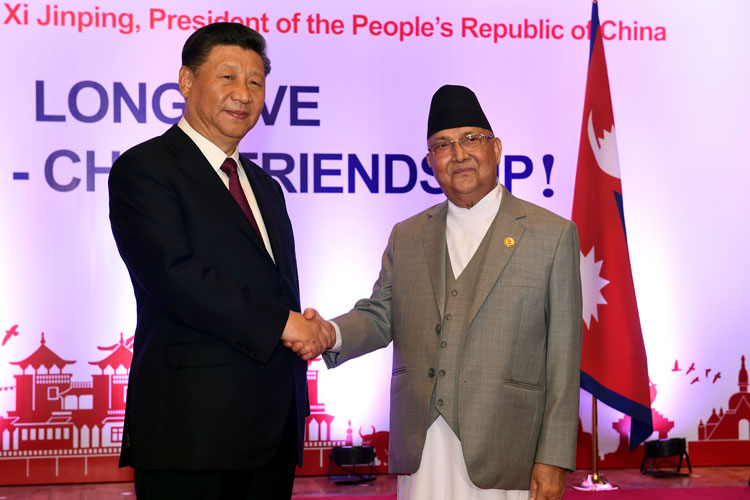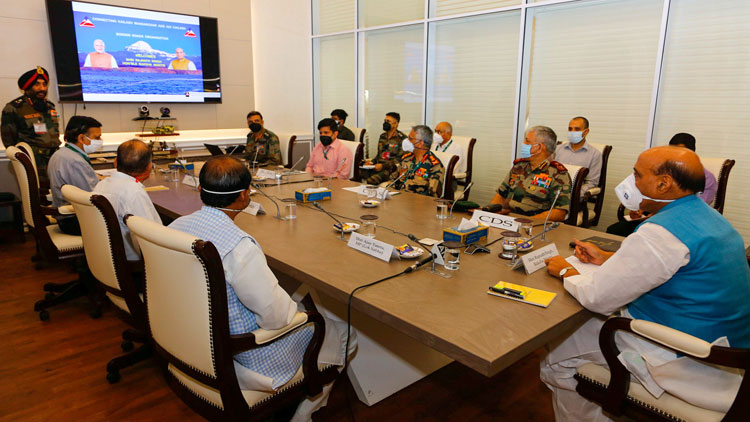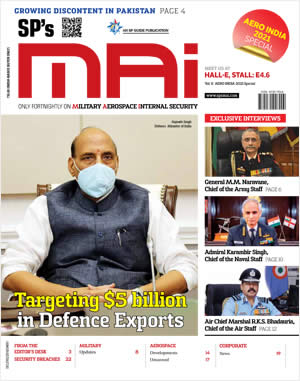INDIAN ARMED FORCES CHIEFS ON OUR RELENTLESS AND FOCUSED PUBLISHING EFFORTS

SP Guide Publications puts forth a well compiled articulation of issues, pursuits and accomplishments of the Indian Army, over the years

"Over the past 60 years, the growth of SP Guide Publications has mirrored the rising stature of Indian Navy. Its well-researched and informative magazines on Defence and Aerospace sector have served to shape an educated opinion of our military personnel, policy makers and the public alike. I wish SP's Publication team continued success, fair winds and following seas in all future endeavour!"

Since, its inception in 1964, SP Guide Publications has consistently demonstrated commitment to high-quality journalism in the aerospace and defence sectors, earning a well-deserved reputation as Asia's largest media house in this domain. I wish SP Guide Publications continued success in its pursuit of excellence.
- Indian Air Force Aims for Full Indigenous Inventory by 2047 — Air Chief Marshal A.P. Singh
- General Upendra Dwivedi takes over as the Chief of the Army Staff
- Rajnath Singh assumes charge as Defence Minister for the second consecutive term
- Admiral Dinesh K. Tripathi assumes Command of the Indian Navy as 26th Chief of the Naval Staff
- Prime Minister witnesses 'Bharat Shakti' – a Tri-Services Firing and Manoeuvre Exercise in Pokhran, Rajasthan
Nepal Turns Chinese Proxy
 |
The Author is Former Director General of Information Systems and A Special Forces Veteran, Indian Army |

In a show of open defiance to India, Nepal has unveiled a new political map in which the Indian areas of Limpiyadhura, Lipulekh and Kalapani are shown within Nepal. Lipulekh Pass is on the Line of Actual Control (LAC) between India and China Occupied Tibet (COT). Indian troops have been deployed at Limpiyadhura and Kalapani over past five decades. India Ministry of External Affairs (MEA) has responded by saying the new map amounts to "artificial enlargement of territorial claims" that are not acceptable to India. However, Nepal’s Prime Minister K.P. Sharma Oli in his address to the Nepalese Parliament has stated that the Constitution will be amended to formalise this map. He also stated that this issue will not be allowed to fade away and that diplomatic efforts will be made to bring back the territories. Oli also told Parliament that the “virus from India looks more lethal than Chinese and Italian”. This statement by Oli was despite Indian assistance to Nepal for fighting COVID-19. On May 8, after India’s Defence Minister inaugurated a road to Lipulekh Pass on the LAC for Kailash-Mansarovar pilgrimage, Nepal called it territorial violation though India's foreign ministry had said the road was completely within India. Indian Army Chief told media, “Nepal’s ambassador had mentioned that the east side of Kali Nadi (Mahakali River) belongs to them. There is no dispute in that. The road which we have constructed is on the west side of the river…. they might have raised the issue on the behest of someone else. That is very much a possibility.” Nepal’s new map mirrors China’s cartographic patent; Beijing is clearly behind Nepal’s anti-India stance. Interestingly, Kathmandu-based ‘Greater Nepal’ displays a map showing areas in India and even Bangladesh belonging to Nepal; reflecting China’s dream to cut off India’s northeast sometime in future.
The China-sponsored bloody Maoist insurgency in Nepal killed 19,000 Nepalese between 1996 and 2005, internally displacing 100,000-150,000. In June 2001, Nepal’s royal family was massacred. China brought together Communist Party of Nepal (UML) and Communist Party of Nepal (Maoist Centre) to establish a government in Nepal opposed to the US and India. Oli and Pushpa Kumar Dahal alias Prachanda both belong to communist parties linked to Maoist insurgency. Oli was arrested in 1970 for subversive politics and later imprisoned for 14 years (1973-1987) heading ‘Jhapa Movement’ responsible for several killings. He was earlier PM from October 2015 to August 2016. Dahal headed Communist Party of Nepal (Maoists) during the civil war and served twice as PM - 2008-2009 and 2016-20017. Dahal told Nepalese media in 2012: “our war will finally be with Indian Army” – peoples war! Given these credentials, China needed no effort to cultivate Oli and Dahal whose individual net worth is reportedly over $1 million that may be grossly understated. Oli withdrew Nepalese army participation last minute from the BIMSTEC multi-nation counter-terrorism (CT) exercise organised in India during September 2018, instead making them participate in a CT exercise in China in the same month.

China has the largest FDI in Nepal and Chinese presence in economic, political, cultural and strategic spheres is rapidly rising especially with Nepal joining China’s BRI in 2017. Anti-India sentiments in Nepal are continuously induced by Beijing. Pakistan’s ISI and Lashkar-e-Taiba (LeT) are active in Nepal. Huo Yangi, China’s ambassador in Nepal, who has only served abroad in America and Pakistan aims to develop Nepal-China relations similar to China-Pakistan including building Nepal’s sub-conventional muscle for benefit of China. Chinese development projects globally have covert presence of PLA, as would Nepal. ISI and LeT are engaged in radicalising sections of Nepalese-Muslim – Muslims are 4.4 percent of Nepal’s population. Recent intelligence reports indicated radicals in a Nepalese mosque plotting to spread COVID-19 in India. Nepal has given oil drilling rights to China in the Terai region bordering India where ISI-LeT are establishing. Nepalese Gorkhas are excellent troops serving in some 38 infantry battalions of Indian Army (some 1,28,000 veterans draw pension from India) and in police plus other security organisations – all told about 45,000. Nepalese working in civil sector in India number about 1-1.5 million. During Nepal’s civil war, Nepalese serving in Indian Army while on leave in Nepal were forced to impart weapon training to Maoists. Nepal’s Parliament has been mulling that Nepalese should not serve in foreign armies albeit finding that many jobs within Nepal would be difficult.
Indian policy towards Nepal has been lackadaisical. Belief of mutual Hindu traditions should be viewed in context of power in Nepal with communists for whom religion is anathema. Anti-India sentiment induced by China, visible since years, was ignored. The 2015 Nepal blockade by default or design resulted in the Nepal-China Transit Transport Agreement under which Nepal can trade with third countries through some land and sea ports in China.Demonetisation was another blow since India currency was freely used in Nepal. Nepal also blames India for inciting Madhesis though it is Nepal’s internal problem. There has been discord between Oli and Dahal but Yangi brokered truce between them. Oli was forced to withdraw two controversial ordinances he wanted passed to consolidate own power. Some reports in Indian media say Nepal’s new map and Oli’s anti-India vitriolic are aimed at his own detractors within Nepal like Dahal and Madhav Kumar Nepal. This is dim-witted or possibly planted to deflect attention. Make no mistakes Nepal’s communists have made Nepal China’s proxy and pose viable threat through borders having check-posts more than a kilometer apart. Terrorists have been coming via Nepal to sabotage railway lines in India. An often heard cliché is that how can we match up with Chinese investments. But money, though important, is only one part how China draws countries into its strategic sphere. India must review its foreign policy and chalk out measures to deal with Nepal’s communist parties.





